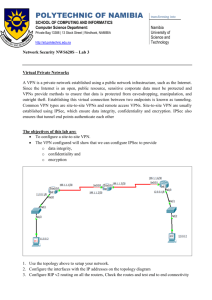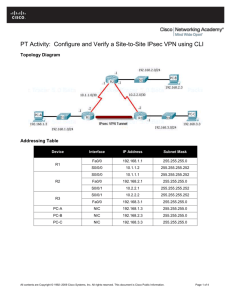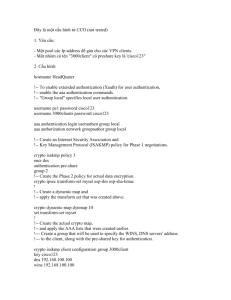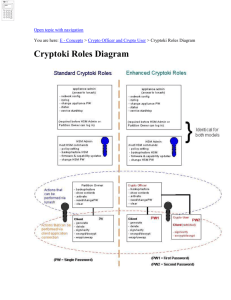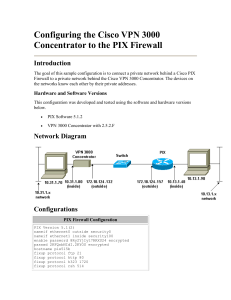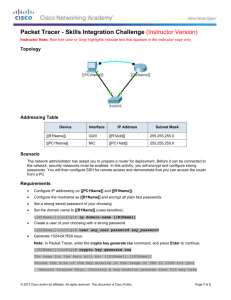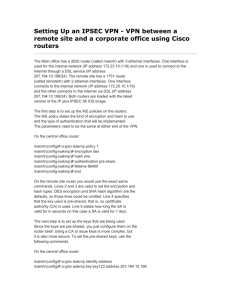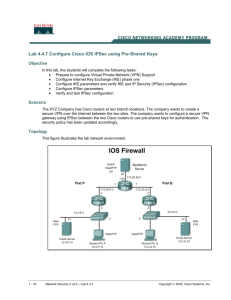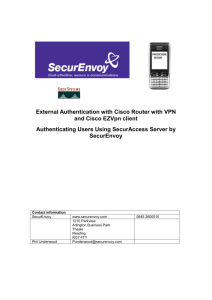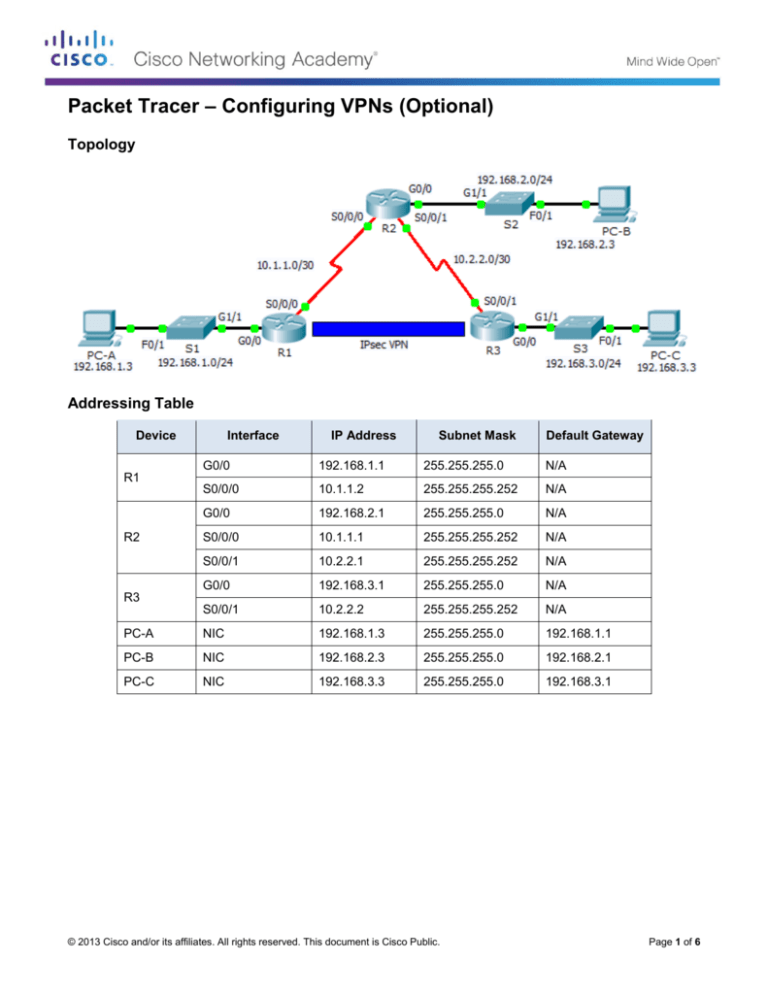
Packet Tracer – Configuring VPNs (Optional)
Topology
Addressing Table
Device
Interface
IP Address
Subnet Mask
Default Gateway
G0/0
192.168.1.1
255.255.255.0
N/A
S0/0/0
10.1.1.2
255.255.255.252
N/A
G0/0
192.168.2.1
255.255.255.0
N/A
S0/0/0
10.1.1.1
255.255.255.252
N/A
S0/0/1
10.2.2.1
255.255.255.252
N/A
G0/0
192.168.3.1
255.255.255.0
N/A
S0/0/1
10.2.2.2
255.255.255.252
N/A
PC-A
NIC
192.168.1.3
255.255.255.0
192.168.1.1
PC-B
NIC
192.168.2.3
255.255.255.0
192.168.2.1
PC-C
NIC
192.168.3.3
255.255.255.0
192.168.3.1
R1
R2
R3
© 2013 Cisco and/or its affiliates. All rights reserved. This document is Cisco Public.
Page 1 of 6
Packet Tracer – Configuring VPNs (Optional)
ISAKMP Phase 1 Policy Parameters
Parameters
R1
R3
Key distribution method
Manual or ISAKMP
ISAKMP
ISAKMP
Encryption algorithm
DES, 3DES, or AES
AES
AES
Hash algorithm
MD5 or SHA-1
SHA-1
SHA-1
Authentication method
Pre-shared keys or RSA
pre-share
pre-share
Key exchange
DH Group 1, 2, or 5
DH 2
DH 2
IKE SA Lifetime
86400 seconds or less
86400
86400
cisco
cisco
ISAKMP Key
Bolded parameters are defaults. Other parameters need to be explicitly configured.
IPsec Phase 2 Policy Parameters
Parameters
R1
R3
Transform Set
VPN-SET
VPN-SET
Peer Hostname
R3
R1
Peer IP Address
10.2.2.2
10.1.1.2
Network to be encrypted
192.168.1.0/24
192.168.3.0/24
Crypto Map name
VPN-MAP
VPN-MAP
SA Establishment
ipsec-isakmp
ipsec-isakmp
Objectives
Part 1: Enable Security Features
Part 2: Configure IPsec Parameters on R1
Part 3: Configure IPsec Parameters on R3
Part 4: Verify the IPsec VPN
Scenario
In this activity, you will configure two routers to support a site-to-site IPsec VPN for traffic flowing from their
respective LANs. The IPsec VPN traffic will pass through another router that has no knowledge of the VPN.
IPsec provides secure transmission of sensitive information over unprotected networks such as the Internet.
IPsec acts at the network layer, protecting and authenticating IP packets between participating IPsec devices
(peers), such as Cisco routers.
Part 1: Enable Security Features
Step 1: Activate securityk9 module.
The Security Technology Package license must be enabled to complete this activity.
© 2013 Cisco and/or its affiliates. All rights reserved. This document is Cisco Public.
Page 2 of 6
Packet Tracer – Configuring VPNs (Optional)
Note: Both the user EXEC and privileged EXEX pass word is cisco.
a. Issue the show version command in the user EXEC or privileged EXEC mode to verify that the Security
Technology Package license is activated.
---------------------------------------------------------------Technology
Technology-package
Technology-package
Current
Type
Next reboot
----------------------------------------------------------------ipbase
ipbasek9
Permanent
ipbasek9
security
None
None
None
uc
None
None
None
data
None
None
None
Configuration register is 0x2102
b. If not, activate the securityk9 module for the next boot of the router, accept the license, save the
configuration, and reboot.
R1(config)# license boot module c2900 technology-package securityk9
R1(config)# end
R1# copy running-config startup-config
R1# reload
c.
After the reloading is completed, issue the show version again to verify the Security Technology
Package license activation.
Technology Package License Information for Module:'c2900'
---------------------------------------------------------------Technology
Technology-package
Technology-package
Current
Type
Next reboot
----------------------------------------------------------------ipbase
ipbasek9
Permanent
ipbasek9
security
securityk9
Evaluation
securityk9
uc
None
None
None
data
None
None
None
d. Repeat Steps 1a to 1c with R3.
Part 2: Configure IPsec Parameters on R1
Step 1: Test connectivity.
Ping from PC-A to PC-C.
Step 2: Identify interesting traffic on R1.
Configure ACL 110 to identify the traffic from the LAN on R1 to the LAN on R3 as interesting. This interesting
traffic will trigger the IPsec VPN to be implemented whenever there is traffic between R1 to R3 LANs. All
other traffic sourced from the LANs will not be encrypted. Remember that due to the implicit deny any, there is
no need to add the statement to the list.
R1(config)# access-list 110 permit ip 192.168.1.0 0.0.0.255 192.168.3.0
0.0.0.255
© 2013 Cisco and/or its affiliates. All rights reserved. This document is Cisco Public.
Page 3 of 6
Packet Tracer – Configuring VPNs (Optional)
Step 3: Configure the ISAKMP Phase 1 properties on R1.
Configure the crypto ISAKMP policy 10 properties on R1 along with the shared crypto key cisco. Refer to the
ISAKMP Phase 1 table for the specific parameters to configure. Default values do not have to be configured
therefore only the encryption, key exchange method, and DH method must be configured.
R1(config)# crypto
R1(config-isakmp)#
R1(config-isakmp)#
R1(config-isakmp)#
R1(config-isakmp)#
R1(config)# crypto
isakmp policy 10
encryption aes
authentication pre-share
group 2
exit
isakmp key cisco address 10.2.2.2
Step 4: Configure the ISAKMP Phase 2 properties on R1.
Create the transform-set VPN-SET to use esp-3des and esp-sha-hmac. Then create the crypto map VPNMAP that binds all of the Phase 2 parameters together. Use sequence number 10 and identify it as an ipsecisakmp map.
R1(config)# crypto ipsec transform-set VPN-SET esp-3des esp-sha-hmac
R1(config)# crypto map VPN-MAP 10 ipsec-isakmp
R1(config-crypto-map)# description VPN connection to R3
R1(config-crypto-map)# set peer 10.2.2.2
R1(config-crypto-map)# set transform-set VPN-SET
R1(config-crypto-map)# match address 110
R1(config-crypto-map)# exit
Step 5: Configure the crypto map on the outgoing interface.
Finally, bind the VPN-MAP crypto map to the outgoing Serial 0/0/0 interface. Note: This is not graded.
R1(config)# interface S0/0/0
R1(config-if)# crypto map VPN-MAP
Part 3: Configure IPsec Parameters on R3
Step 1: Configure router R3 to support a site-to-site VPN with R1.
Now configure reciprocating parameters on R3. Configure ACL 110 identifying the traffic from the LAN on R3
to the LAN on R1 as interesting.
R3(config)# access-list 110 permit ip 192.168.3.0 0.0.0.255 192.168.1.0
0.0.0.255
Step 2: Configure the ISAKMP Phase 1 properties on R3.
Configure the crypto ISAKMP policy 10 properties on R3 along with the shared crypto key cisco.
R3(config)# crypto
R3(config-isakmp)#
R3(config-isakmp)#
R3(config-isakmp)#
R3(config-isakmp)#
R3(config)# crypto
isakmp policy 10
encryption aes
authentication pre-share
group 2
exit
isakmp key cisco address 10.1.1.2
© 2013 Cisco and/or its affiliates. All rights reserved. This document is Cisco Public.
Page 4 of 6
Packet Tracer – Configuring VPNs (Optional)
Step 3: Configure the ISAKMP Phase 2 properties on R1.
Like you did on R1, create the transform-set VPN-SET to use esp-3des and esp-sha-hmac. Then create the
crypto map VPN-MAP that binds all of the Phase 2 parameters together. Use sequence number 10 and
identify it as an ipsec-isakmp map.
R3(config)# crypto ipsec transform-set VPN-SET esp-3des esp-sha-hmac
R3(config)# crypto map VPN-MAP 10 ipsec-isakmp
R3(config-crypto-map)# description VPN connection to R1
R3(config-crypto-map)# set peer 10.1.1.2
R3(config-crypto-map)# set transform-set VPN-SET
R3(config-crypto-map)# match address 110
R3(config-crypto-map)# exit
Step 4: Configure the crypto map on the outgoing interface.
Finally, bind the VPN-MAP crypto map to the outgoing Serial 0/0/1 interface. Note: This is not graded.
R3(config)# interface S0/0/1
R3(config-if)# crypto map VPN-MAP
Part 4: Verify the IPsec VPN
Step 1: Verify the tunnel prior to interesting traffic.
Issue the show crypto ipsec sa command on R1. Notice that the number of packets encapsulated,
encrypted, decapsulated and decrypted are all set to 0.
R1# show crypto ipsec sa
interface: Serial0/0/0
Crypto map tag: VPN-MAP, local addr 10.1.1.2
protected vrf: (none)
local ident (addr/mask/prot/port): (192.168.1.0/255.255.255.0/0/0)
remote ident (addr/mask/prot/port): (192.168.3.0/255.255.255.0/0/0)
current_peer 10.2.2.2 port 500
PERMIT, flags={origin_is_acl,}
#pkts encaps: 0, #pkts encrypt: 0, #pkts digest: 0
#pkts decaps: 0, #pkts decrypt: 0, #pkts verify: 0
#pkts compressed: 0, #pkts decompressed: 0
#pkts not compressed: 0, #pkts compr. failed: 0
#pkts not decompressed: 0, #pkts decompress failed: 0
#send errors 0, #recv errors 0
local crypto endpt.: 10.1.1.2, remote crypto endpt.:10.2.2.2
path mtu 1500, ip mtu 1500, ip mtu idb Serial0/0/0
current outbound spi: 0x0(0)
<output omitted>
Step 2: Create interesting traffic.
Ping PC-C from PC-A.
© 2013 Cisco and/or its affiliates. All rights reserved. This document is Cisco Public.
Page 5 of 6
Packet Tracer – Configuring VPNs (Optional)
Step 3: Verify the tunnel after interesting traffic.
On R1, re-issue the show crypto ipsec sa command. Now notice that the number of packets is more than 0
indicating that the IPsec VPN tunnel is working.
R1# show crypto ipsec sa
interface: Serial0/0/0
Crypto map tag: VPN-MAP, local addr 10.1.1.2
protected vrf: (none)
local ident (addr/mask/prot/port): (192.168.1.0/255.255.255.0/0/0)
remote ident (addr/mask/prot/port): (192.168.3.0/255.255.255.0/0/0)
current_peer 10.2.2.2 port 500
PERMIT, flags={origin_is_acl,}
#pkts encaps: 3, #pkts encrypt: 3, #pkts digest: 0
#pkts decaps: 3, #pkts decrypt: 3, #pkts verify: 0
#pkts compressed: 0, #pkts decompressed: 0
#pkts not compressed: 0, #pkts compr. failed: 0
#pkts not decompressed: 0, #pkts decompress failed: 0
#send errors 1, #recv errors 0
local crypto endpt.: 10.1.1.2, remote crypto endpt.:10.2.2.2
path mtu 1500, ip mtu 1500, ip mtu idb Serial0/0/0
current outbound spi: 0x0A496941(172583233)
<output omitted>
Step 4: Create uninteresting traffic.
Ping PC-B from PC-A.
Step 5: Verify the tunnel.
On R1, re-issue the show crypto ipsec sa command. Finally, notice that the number of packets has not
changed verifying that uninteresting traffic is not encrypted.
© 2013 Cisco and/or its affiliates. All rights reserved. This document is Cisco Public.
Page 6 of 6

